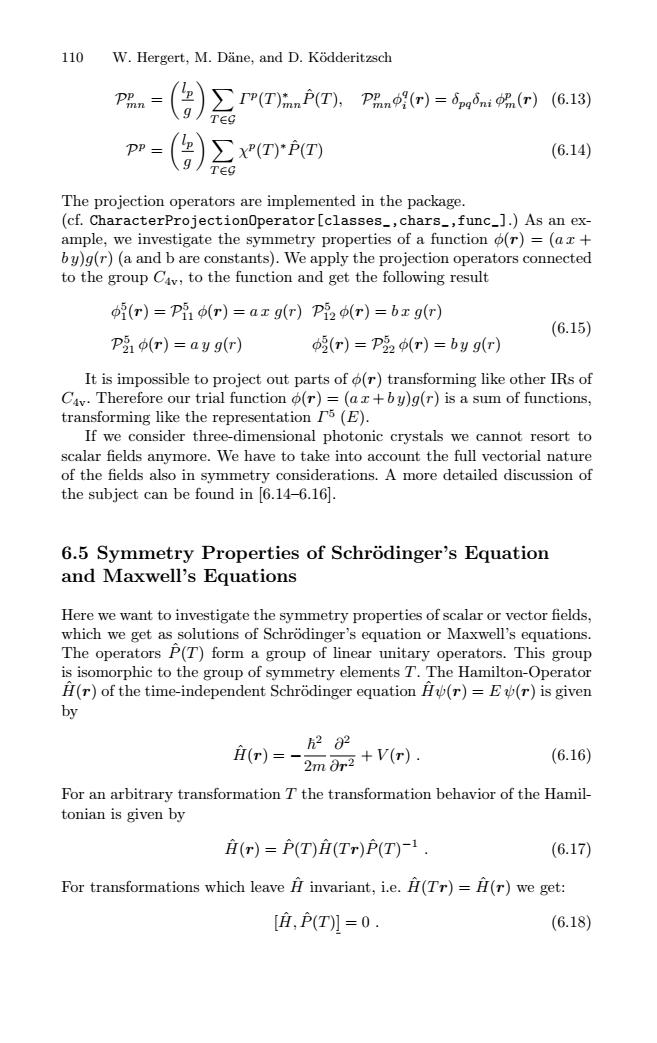正在加载图片...

110 W.Hergert,M.Dane,and D.Kodderitzsch >(T)mP(T),Pn9(r)=6p(r)(6.13) T∈G ∑x(T)*P(T) (6.14) TeG The projection operators are implemented in the package. (cf.CharacterProjectionOperator[classes_,chars_,func_].)As an ex- ample,we investigate the symmetry properties of a function o(r)=(ax+ by)g(r)(a and b are constants).We apply the projection operators connected to the group Cav,to the function and get the following result (r)=Pio(r)=az g(r)Pi2o(r)=bz g(r) (6.15) Pio(r)=ayg(r) (r)=P2(r))=byg(r) It is impossible to project out parts of (r)transforming like other IRs of Cav.Therefore our trial function o(r)=(ax+by)g(r)is a sum of functions, transforming like the representation I'5 (E). If we consider three-dimensional photonic crystals we cannot resort to scalar fields anymore.We have to take into account the full vectorial nature of the fields also in symmetry considerations.A more detailed discussion of the subject can be found in 6.14-6.16]. 6.5 Symmetry Properties of Schrodinger's Equation and Maxwell's Equations Here we want to investigate the symmetry properties of scalar or vector fields, which we get as solutions of Schrodinger's equation or Maxwell's equations. The operators P(T)form a group of linear unitary operators.This group is isomorphic to the group of symmetry elements T.The Hamilton-Operator H(r)of the time-independent Schrodinger equation H(r)=E(r)is given by h202 H(r)=-2m8m2+V(r). (6.16) For an arbitrary transformation T the transformation behavior of the Hamil- tonian is given by (r)=P(T)(Tr)P(T)-1. (6.17) For transformations which leave产invariant,.i.e.a(Tr)=H(r)we get: [a,P(T1=0. (6.18)110 W. Hergert, M. D¨ane, and D. K¨odderitzsch Pp mn = lp g T∈G Γp(T) ∗ mnPˆ(T), Pp mnφq i (r) = δpqδni φp m(r) (6.13) Pp = lp g T∈G χp(T) ∗Pˆ(T) (6.14) The projection operators are implemented in the package. (cf. CharacterProjectionOperator[classes_,chars_,func_].) As an example, we investigate the symmetry properties of a function φ(r)=(a x + b y)g(r) (a and b are constants). We apply the projection operators connected to the group C4v, to the function and get the following result φ5 1(r) = P5 11 φ(r) = axg(r) P5 12 φ(r) = bxg(r) P5 21 φ(r) = ay g(r) φ5 2(r) = P5 22 φ(r) = by g(r) (6.15) It is impossible to project out parts of φ(r) transforming like other IRs of C4v. Therefore our trial function φ(r)=(a x + b y)g(r) is a sum of functions, transforming like the representation Γ5 (E). If we consider three-dimensional photonic crystals we cannot resort to scalar fields anymore. We have to take into account the full vectorial nature of the fields also in symmetry considerations. A more detailed discussion of the subject can be found in [6.14–6.16]. 6.5 Symmetry Properties of Schr¨odinger’s Equation and Maxwell’s Equations Here we want to investigate the symmetry properties of scalar or vector fields, which we get as solutions of Schr¨odinger’s equation or Maxwell’s equations. The operators Pˆ(T) form a group of linear unitary operators. This group is isomorphic to the group of symmetry elements T. The Hamilton-Operator Hˆ (r) of the time-independent Schr¨odinger equation Hψˆ (r) = E ψ(r) is given by Hˆ (r) = − 2 2m ∂2 ∂r2 + V (r) . (6.16) For an arbitrary transformation T the transformation behavior of the Hamiltonian is given by Hˆ (r) = Pˆ(T)Hˆ (Tr)Pˆ(T) −1 . (6.17) For transformations which leave Hˆ invariant, i.e. Hˆ (Tr) = Hˆ (r) we get: [H, ˆ Pˆ(T)] = 0 . (6.18)